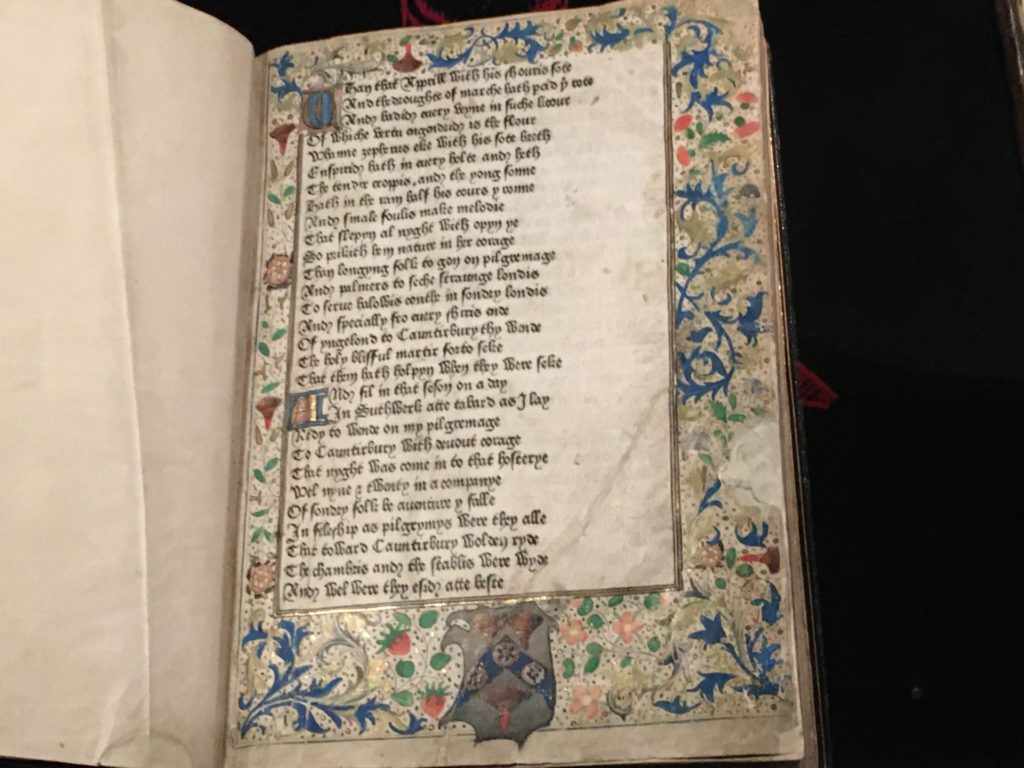Chaucer, the “Father of English literature”, celebrated in Oxford exhibition.
Geoffrey Chaucer’s life, c.1343 – 1400, and his world-famous Canterbury Tales are celebrated in a magnificent exhibition in Oxford’s Weston Library running until 28th April. Visit: Chaucer Here and Now | Visit the Bodleian Libraries (ox.ac.uk). Copies of richly illuminated medieval manuscripts are amongst the numerous exhibits that show the importance of Chaucer’s work to the development of English literature.
He was the son of a wealthy London vintner who rose to occupy various high offices of state, including Justice of the Peace and knight of the shire for Kent. He was its Member of Parliament. He travelled widely in France and Italy as a diplomat. He was influenced by French poetry as well as, especially, by the work of Italian poets like Boccaccio and Petrarch. He chose, however, to write in English at a time when court poetry was predominantly written in Anglo-Norman and Latin.
Included in the exhibition are the oldest existing manuscript of the Canterbury Tales (the Hengwrt Chaucer from the National Library of Wales), a very rare copy of William Caxton’s early printed first edition (1476-77) and the more colourful second edition with woodcut illustrations (1483). The beautiful Kelmscott Chaucer (1896) by William Morris and Edward Burne-Jones, major figures of the Arts & Crafts Movement and Pre-Raphaelites, provides another highlight.
He wrote a wide body of works, including the scientific A Treatise on the Astrolabe for his son, demonstrating that he was a major figure in the emerging European Renaissance. The exhibition focuses mainly, however, on the Canterbury Tales. Its fame rests on the fact that it gave voice to a range of English characters from 14th century, including the infamous Wife of Bath, whose earthy no-nonsense view of life has resonated through the ages. Variously seen as scandalous or as an early feminist, the more colourful elements of her tale are sanitised in versions of the work published in 19th and 20th centuries, when the British Empire lionised this great national genius along with Shakespeare and when children’s editions evoked a sentimental merrie olde England of the past.
The Cambridge Guide to Literature sums up his work as follows, “Chaucer’s blend of humour, realism, philosophical depth, poetic virtuosity, and masterful control of dialogue and character was never matched.”
Chaucer was buried in Westminster Abbey in a spot that later led to the development of Poets’ Corner, where today are also commemorated, and sometimes buried, over 100 writers, amongst them the Brontë sisters, Dickens and Handel.
An article written by Colin Bloxham






Very soon this site will be famous among all blog
visitors, due to it’s nice articles
It?¦s really a cool and helpful piece of information. I am satisfied that you just shared this helpful info with us. Please keep us up to date like this. Thank you for sharing.